Jaguar E-Pace vs Nissan Juke – Differences & prices compared
Both models have their strengths – but which one suits you more?
Compare performance, efficiency, price and space directly: Jaguar E-Pace or Nissan Juke?
Here’s where it gets real: The technical differences in detail
Costs and Efficiency: Looking at overall running costs, both models reveal some interesting differences in everyday economy.
Nissan Juke has a convincingly advantage in terms of price – it starts at 21400 £, while the Jaguar E-Pace costs 32400 £. That’s a price difference of around 11015 £.
Fuel consumption also shows a difference: the Jaguar E-Pace manages with 1.40 L and is therefore decisively more efficient than the Nissan Juke with 4.70 L. The difference is about 3.30 L per 100 km.
Engine and Performance: Power, torque and acceleration say a lot about how a car feels on the road. This is where you see which model delivers more driving dynamics.
When it comes to engine power, the Jaguar E-Pace has a clearly edge – offering 269 HP compared to 143 HP. That’s roughly 126 HP more horsepower.
In acceleration from 0 to 100 km/h, the Jaguar E-Pace is clearly perceptible quicker – completing the sprint in 7.30 s, while the Nissan Juke takes 10.10 s. That’s about 2.80 s faster.
In terms of top speed, the Jaguar E-Pace performs slightly better – reaching 211 km/h, while the Nissan Juke tops out at 180 km/h. The difference is around 31 km/h.
There’s also a difference in torque: the Jaguar E-Pace pulls significantly stronger with 540 Nm compared to 200 Nm. That’s about 340 Nm difference.
Space and Everyday Use: Beyond pure performance, interior space and usability matter most in daily life. This is where you see which car is more practical and versatile.
Both vehicles offer seating for 5 people.
In curb weight, the Nissan Juke is distinct lighter – 1274 kg compared to 1783 kg. The difference is around 509 kg.
In terms of boot space, the Jaguar E-Pace offers slightly more room – 494 L compared to 422 L. That’s a difference of about 72 L.
In maximum load capacity, the Nissan Juke performs a bit better – up to 1305 L, which is about 135 L more than the Jaguar E-Pace.
When it comes to payload, Jaguar E-Pace distinct takes the win – 554 kg compared to 427 kg. That’s a difference of about 127 kg.
All in all, the Jaguar E-Pace shows itself to be wins the duel decisively and secures the title of DriveDuel Champion.
It impresses with the more balanced overall package and proves to be the more versatile companion for everyday use.
Jaguar E-Pace
The Jaguar E-Pace is a compact SUV that combines the brand's signature luxury with a dynamic driving experience. Its sleek design features graceful lines and an assertive stance, making it a standout on any road. Inside, the E-Pace boasts a meticulously crafted interior with high-quality materials and advanced technology, providing both comfort and connectivity for drivers and passengers alike.
details @ media.jaguar.com
@ media.jaguar.com
 @ media.jaguar.com
@ media.jaguar.com
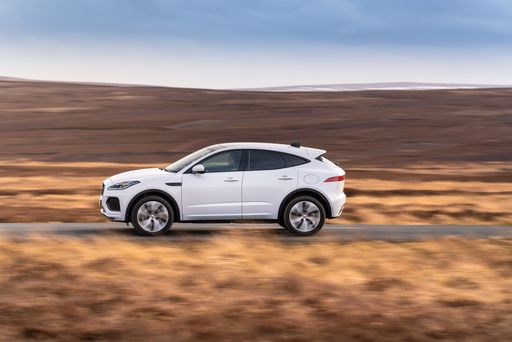 @ media.jaguar.com
@ media.jaguar.com
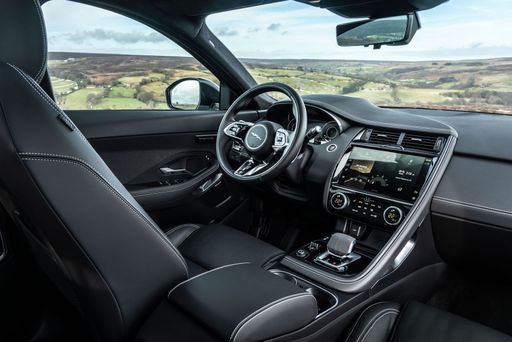 @ media.jaguar.com
@ media.jaguar.com
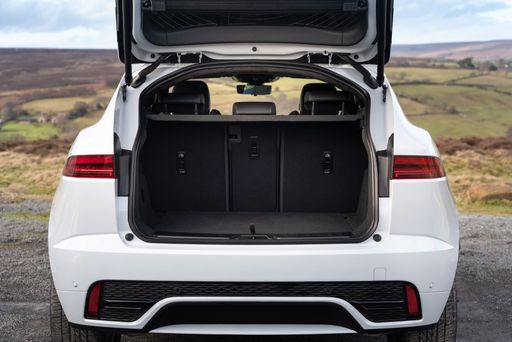 @ media.jaguar.com
@ media.jaguar.com
Nissan Juke
The Nissan Juke stands out with its distinctive design and bold styling, making it a popular choice for those seeking something different on the road. Its interior cleverly combines modern technology with comfort, offering an enjoyable driving experience for both the driver and passengers. Despite its compact size, the Juke provides a surprising amount of space and versatility, making it suitable for urban adventures and weekend getaways alike.
details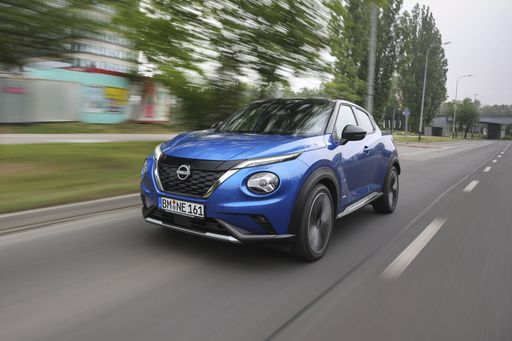 @ germany.nissannews.com
@ germany.nissannews.com
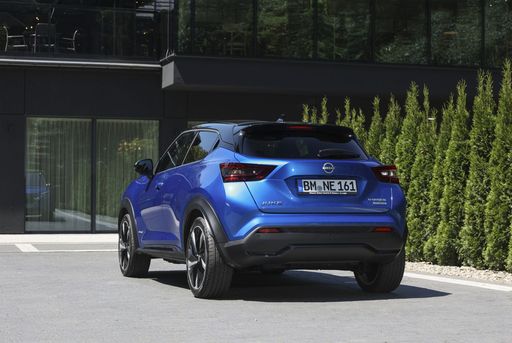 @ germany.nissannews.com
@ germany.nissannews.com
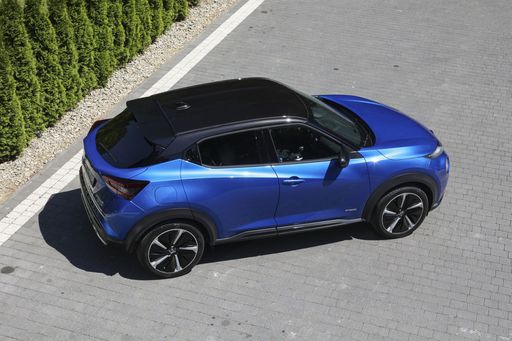 @ germany.nissannews.com
@ germany.nissannews.com
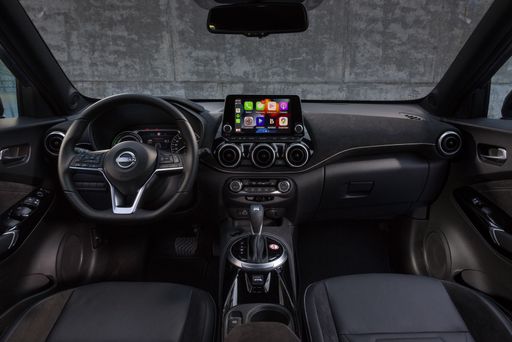 @ germany.nissannews.com
@ germany.nissannews.com

|

|
|
|
|
Costs and Consumption |
|
|---|---|
|
Price
32400 - 56100 £
|
Price
21400 - 30100 £
|
|
Consumption L/100km
1.4 - 8.2 L
|
Consumption L/100km
4.7 - 6 L
|
|
Consumption kWh/100km
-
|
Consumption kWh/100km
-
|
|
Electric Range
69 km
|
Electric Range
-
|
|
Battery Capacity
11.50 kWh
|
Battery Capacity
0.60 kWh
|
|
co2
33 - 185 g/km
|
co2
107 - 136 g/km
|
|
Fuel tank capacity
56 - 67 L
|
Fuel tank capacity
46 L
|
Dimensions and Body |
|
|---|---|
|
Body Type
SUV
|
Body Type
SUV
|
|
Seats
5
|
Seats
5
|
|
Doors
5
|
Doors
5
|
|
Curb weight
1783 - 2173 kg
|
Curb weight
1274 - 1405 kg
|
|
Trunk capacity
494 L
|
Trunk capacity
354 - 422 L
|
|
Length
4395 mm
|
Length
4210 mm
|
|
Width
1984 mm
|
Width
1800 mm
|
|
Height
1648 mm
|
Height
1593 mm
|
|
Max trunk capacity
1170 L
|
Max trunk capacity
1237 - 1305 L
|
|
Payload
497 - 554 kg
|
Payload
405 - 427 kg
|
Engine and Performance |
|
|---|---|
|
Engine Type
Plugin Hybrid, Diesel MHEV, Petrol MHEV
|
Engine Type
Petrol, Full Hybrid
|
|
Transmission
Automatic
|
Transmission
Manuel, Automatic
|
|
Transmission Detail
Automatic Gearbox
|
Transmission Detail
Manual Gearbox, Dual-Clutch Automatic, Automatic Gearbox
|
|
Drive Type
All-Wheel Drive, Front-Wheel Drive
|
Drive Type
Front-Wheel Drive
|
|
Power HP
160 - 269 HP
|
Power HP
114 - 143 HP
|
|
Acceleration 0-100km/h
7.3 - 10.5 s
|
Acceleration 0-100km/h
10.1 - 11.8 s
|
|
Max Speed
190 - 211 km/h
|
Max Speed
166 - 180 km/h
|
|
Torque
260 - 540 Nm
|
Torque
200 Nm
|
|
Number of Cylinders
3 - 4
|
Number of Cylinders
3 - 4
|
|
Power kW
118 - 198 kW
|
Power kW
84 - 105 kW
|
|
Engine capacity
1498 - 1998 cm3
|
Engine capacity
999 - 1598 cm3
|
General |
|
|---|---|
|
Model Year
2024
|
Model Year
2024
|
|
CO2 Efficiency Class
B, G
|
CO2 Efficiency Class
D, E, C
|
|
Brand
Jaguar
|
Brand
Nissan
|
What drive types are available for the Jaguar E-Pace?
The Jaguar E-Pace is offered with All-Wheel Drive or Front-Wheel Drive.
The prices and data displayed are estimates based on German list prices and may vary by country. This information is not legally binding.
